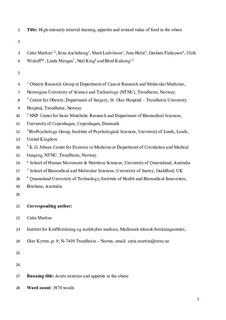| dc.contributor.author | Martins, Catia | |
| dc.contributor.author | Aschehoug, Irina | |
| dc.contributor.author | Ludviksen, Marit Krey | |
| dc.contributor.author | Holst, Jens | |
| dc.contributor.author | Finlayson, Graham | |
| dc.contributor.author | Wisløff, Ulrik | |
| dc.contributor.author | Morgan, Linda | |
| dc.contributor.author | King, Neil | |
| dc.contributor.author | Kulseng, Bård Eirik | |
| dc.date.accessioned | 2018-02-23T13:50:40Z | |
| dc.date.available | 2018-02-23T13:50:40Z | |
| dc.date.created | 2017-12-05T10:52:34Z | |
| dc.date.issued | 2017 | |
| dc.identifier.citation | Medicine & Science in Sports & Exercise. 2017, 49 (9), 1851-1858. | nb_NO |
| dc.identifier.issn | 0195-9131 | |
| dc.identifier.uri | http://hdl.handle.net/11250/2486794 | |
| dc.description.abstract | Purpose Studies on the effect of chronic interval training on appetite in the obese population are scarce. The aim of this study was to determine the effect of 12 wk of isocaloric programs of moderate-intensity continuous training (MICT), high-intensity interval training (HIIT), or short-duration HIIT on subjective feelings of appetite, appetite-related hormones, and reward value of food in sedentary obese individuals.
Methods Forty-six sedentary obese individuals (30 women and 16 men), with a body mass index of 33.3 ± 2.9 kg·m−2 and age of 34.4 ± 8.8 yr, were randomly assigned to one of the three training groups: MICT (n = 14), HIIT (n = 16), or short-duration HIIT (n = 16). Exercise was performed three times per week for 12 wk. Subjective feelings of appetite and plasma levels of acylated ghrelin, polypeptide YY3–36, and glucagon-like peptide 1 were measured before and after a standard breakfast (every 30 min up to 3 h), before and after the exercise intervention. Fat and sweet taste preferences and food reward were measured using the Leeds Food Preference Questionnaire.
Results A significant increase in fasting and postprandial feelings of hunger was observed with the exercise intervention (P = 0.01 and P = 0.048, respectively), but no effect of group and no interaction. No significant effect of exercise intervention, group, or interaction was found on fasting or postprandial subjective feelings of fullness, desire to eat, and prospective food consumption or plasma concentration of acylated ghrelin, polypeptide YY3–36, and glucagon-like peptide 1. No changes in food preference or reward over time, differences between groups, or interactions were found.
Conclusions This study suggests that chronic HIIT has no independent effect on appetite or food reward when compared with an isocaloric program of MICT in obese individuals. | nb_NO |
| dc.language.iso | eng | nb_NO |
| dc.publisher | Wolters Kluwer | nb_NO |
| dc.title | High-intensity interval training, appetite, and reward value of food in the obese | nb_NO |
| dc.type | Journal article | nb_NO |
| dc.type | Peer reviewed | nb_NO |
| dc.description.version | acceptedVersion | nb_NO |
| dc.source.pagenumber | 1851-1858 | nb_NO |
| dc.source.volume | 49 | nb_NO |
| dc.source.journal | Medicine & Science in Sports & Exercise | nb_NO |
| dc.source.issue | 9 | nb_NO |
| dc.identifier.doi | 10.1249/MSS.0000000000001296 | |
| dc.identifier.cristin | 1522866 | |
| dc.description.localcode | Copyright © 2017 by the American College of Sports Medicine. This is the authors' accepted and reviewed manuscript of the article, locked until September 2018 due to copyright restricitons. | nb_NO |
| cristin.unitcode | 194,65,15,0 | |
| cristin.unitcode | 194,65,25,0 | |
| cristin.unitname | Institutt for klinisk og molekylær medisin | |
| cristin.unitname | Institutt for sirkulasjon og bildediagnostikk | |
| cristin.ispublished | true | |
| cristin.fulltext | original | |
| cristin.qualitycode | 2 | |
